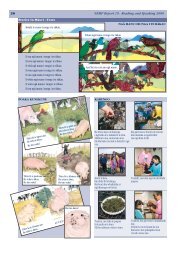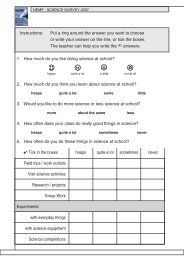graphs
Graphs Tables & Maps 2007.pdf - NEMP - University of Otago
Graphs Tables & Maps 2007.pdf - NEMP - University of Otago
- No tags were found...
Create successful ePaper yourself
Turn your PDF publications into a flip-book with our unique Google optimized e-Paper software.
The National Education Monitoring Project1<br />
This chapter presents a concise<br />
outline of the rationale and operating<br />
procedures for national monitoring,<br />
together with some information about<br />
the reactions of participants in the 2007<br />
assessments. Detailed information<br />
about the sample of students and<br />
schools is available in the Appendix.<br />
Purpose of National Monitoring<br />
The New Zealand Curriculum<br />
Framework (1993, p26) states that<br />
the purpose of national monitoring<br />
is to provide information on how well<br />
overall national standards are being<br />
maintained, and where improvements<br />
might be needed.<br />
The focus of the National Education<br />
Monitoring Project (NEMP) is on<br />
the educational achievements and<br />
attitudes of New Zealand primary<br />
and intermediate school children.<br />
NEMP provides a national “snapshot”<br />
of children’s knowledge, skills and<br />
motivation, and a way to identify<br />
which aspects are improving, staying<br />
constant or declining. This information<br />
allows successes to be celebrated and<br />
priorities for curriculum change and<br />
teacher development to be debated<br />
more effectively, with the goal of<br />
helping to improve the education which<br />
children receive.<br />
Assessment and reporting procedures<br />
are designed to provide a rich picture<br />
of what children can do and thus to<br />
optimise value to the educational<br />
community. The result is a detailed<br />
national picture of student achievement.<br />
It is neither feasible nor<br />
appropriate, given the purpose and the<br />
approach used, to release information<br />
about individual students or schools.<br />
Monitoring at Two Class Levels<br />
National monitoring assesses and<br />
reports what children know and<br />
can do at two levels in primary and<br />
intermediate schools: year 4 (ages<br />
8-9) and year 8 (ages 12-13).<br />
National Samples of Students<br />
National monitoring information is<br />
gathered using carefully selected<br />
random samples of students, rather<br />
than all year 4 and year 8 students.<br />
This enables a relatively extensive<br />
exploration of students’ achievement,<br />
far more detailed than would be<br />
possible if all students were to be<br />
assessed. The main national samples<br />
of 1440 year 4 children and 1440 year<br />
8 children represent about 2.5% of the<br />
children at those levels in New Zealand<br />
schools, large enough samples to give<br />
a trustworthy national picture.<br />
Three Sets of Tasks at Each Level<br />
So that a considerable amount<br />
of information can be gathered<br />
without placing too many demands<br />
on individual students, different<br />
students attempt different tasks. The<br />
1440 students selected in the main<br />
sample at each year level are divided<br />
into three groups of 480 students,<br />
comprising four students from each of<br />
120 schools. Each group attempts one<br />
third of the tasks.<br />
Timing of Assessments<br />
The assessments take place in the<br />
second half of the school year, between<br />
August and November. The year 8<br />
assessments occur first, over a fiveweek<br />
period. The year 4 assessments<br />
follow, over a similar period. Each<br />
student participates in about four<br />
hours of assessment activities spread<br />
over one week.<br />
Chapter 1 : The National Education Monitoring Project<br />
5






